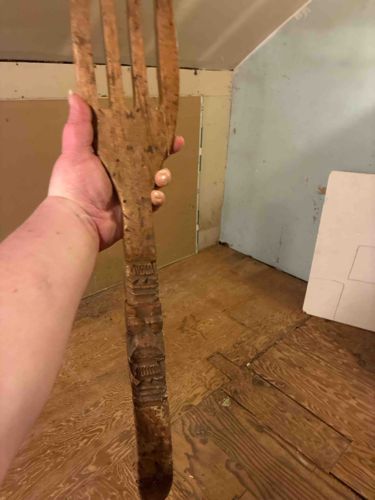
Large Hand-Carved Wooden Fork
The item is an old, large wooden fork, seemingly hand-carved, with four tines. It displays significant signs of age and use, characterized by a dark, possibly stained or naturally aged patina that suggests a long history. The wood appears to be a light-colored hardwood, possibly oak or ash, now darkened with age, and shows an inconsistent coloration with lighter areas visible particularly on the tines and grip where wear might have occurred. The surface exhibits a rough, somewhat unfinished texture, indicative of rudimentary carving or considerable erosion over time. The tines are thick and squared, not finely tapered, which further supports its likely use as a functional, durable tool rather than a refined dining utensil. The handle of the fork is thick and substantial, designed for a firm grip, and features intricate, albeit somewhat worn, carved decorations. These carvings appear to consist of geometric patterns and perhaps stylized figures or symbols, arranged in a stacked, totem-pole like manner along the length of the handle. The details of these carvings are somewhat obscured by the item's age, grime, and wear, but their presence suggests a decorative, possibly cultural, significance beyond mere utility. There are visible chips, dents, and abrasions across the entire piece, consistent with heavy use and prolonged exposure to elements, as well as possible insect damage or natural wood splitting. No discernible maker's marks or signatures are visible in the provided image. The overall construction implies a robust, rustic piece, possibly from an agricultural or domestic setting from an earlier century, perhaps late 19th or early 20th century, given its primitive aesthetic and heavy wear.
AI-Generated Appraisal Disclaimer
Estimated Value
$100-250
Basic Information
Category
Folk Art/Utensil
Appraised On
December 1, 2025
Estimated Value
$100-250
Item Description
The item is an old, large wooden fork, seemingly hand-carved, with four tines. It displays significant signs of age and use, characterized by a dark, possibly stained or naturally aged patina that suggests a long history. The wood appears to be a light-colored hardwood, possibly oak or ash, now darkened with age, and shows an inconsistent coloration with lighter areas visible particularly on the tines and grip where wear might have occurred. The surface exhibits a rough, somewhat unfinished texture, indicative of rudimentary carving or considerable erosion over time. The tines are thick and squared, not finely tapered, which further supports its likely use as a functional, durable tool rather than a refined dining utensil. The handle of the fork is thick and substantial, designed for a firm grip, and features intricate, albeit somewhat worn, carved decorations. These carvings appear to consist of geometric patterns and perhaps stylized figures or symbols, arranged in a stacked, totem-pole like manner along the length of the handle. The details of these carvings are somewhat obscured by the item's age, grime, and wear, but their presence suggests a decorative, possibly cultural, significance beyond mere utility. There are visible chips, dents, and abrasions across the entire piece, consistent with heavy use and prolonged exposure to elements, as well as possible insect damage or natural wood splitting. No discernible maker's marks or signatures are visible in the provided image. The overall construction implies a robust, rustic piece, possibly from an agricultural or domestic setting from an earlier century, perhaps late 19th or early 20th century, given its primitive aesthetic and heavy wear.
Related Tags
Get Your Items Appraised
Instant estimates of your treasures with AI-powered instant appraisals